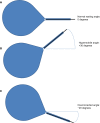Prevention and management of postoperative urinary retention after urogynecologic surgery
- PMID: 25210477
- PMCID: PMC4156001
- DOI: 10.2147/IJWH.S55383
Prevention and management of postoperative urinary retention after urogynecologic surgery
Abstract
Postoperative urinary retention (POUR) is a frequent consequence of gynecologic surgery, especially with surgical correction of urinary incontinence and pelvic organ prolapse. Estimates of retention rates after pelvic surgery range from 2.5%-43%. While there is no standard definition for POUR, it is characterized by impaired bladder emptying, with an elevation in the volume of retained urine. The key to management of POUR is early identification. All patients undergoing pelvic surgery, especially for the correction of incontinence or prolapse, should have an assessment of voiding function prior to discharge. There are several ways to assess voiding function - the gold standard is by measuring a postvoid residual. Management of POUR is fairly straightforward. The goal is to decompress the bladder to avoid long-term damage to bladder integrity and function. The decision regarding when to discontinue catheter-assisted bladder drainage in the postoperative period can be assessed in an ongoing fashion by measurement of postvoid residual. The rate of prolonged POUR beyond 4 weeks is low, and therefore most retention can be expected to resolve spontaneously within 4-6 weeks. When POUR does not resolve spontaneously, more active management may be required. Techniques include urethral dilation, sling stretching, sling incision, partial sling resection, and urethrolysis. While some risk of POUR is inevitable, there are risk factors that are modifiable. Patients that are at higher risk - either due to the procedures being performed or their clinical risk factors - should be counseled regarding the risks and management options for POUR prior to their surgery. Although POUR is a serious condition that can have serious consequences if left untreated, it is easily diagnosed and typically self-resolves. Clinician awareness of the condition and vigilance in its diagnosis are the key factors to successful care for patients undergoing surgical repair.
Keywords: incontinence; postoperative; prolapse; urinary retention.
Figures

References
-
- Buchko BL, Robinson LE. An evidence-based approach to decrease early postoperative urinary retention following urogynecologic surgery. Urol Nurs. 2012;32(5):260–264. - PubMed
-
- Dörflinger A, Monga A. Voiding dysfunction. Curr Opin Obstet Gynecol. 2001;13(5):507–512. - PubMed
-
- Partoll LM. Efficacy of tension-free vaginal tape with other pelvic reconstructive surgery. Am J Obstet Gynecol. 2002;186(6):1292–1295. discussion 1295–1298. - PubMed
-
- MacLean AB, Cardozo L. Incontinence in Women. London, UK: Royal College of Obstetricians and Gynaecologitsts Press; 2002.
-
- Foster RT, Borawski KM, South MM, Weidner AC, Webster GD, Amundsen CL. A randomized, controlled trial evaluating 2 techniques of postoperative bladder testing after transvaginal surgery. Am J Obstet Gynecol. 2007;197(6):627.e1–627.e4. - PubMed
Publication types
LinkOut - more resources
Full Text Sources
Other Literature Sources
Medical

